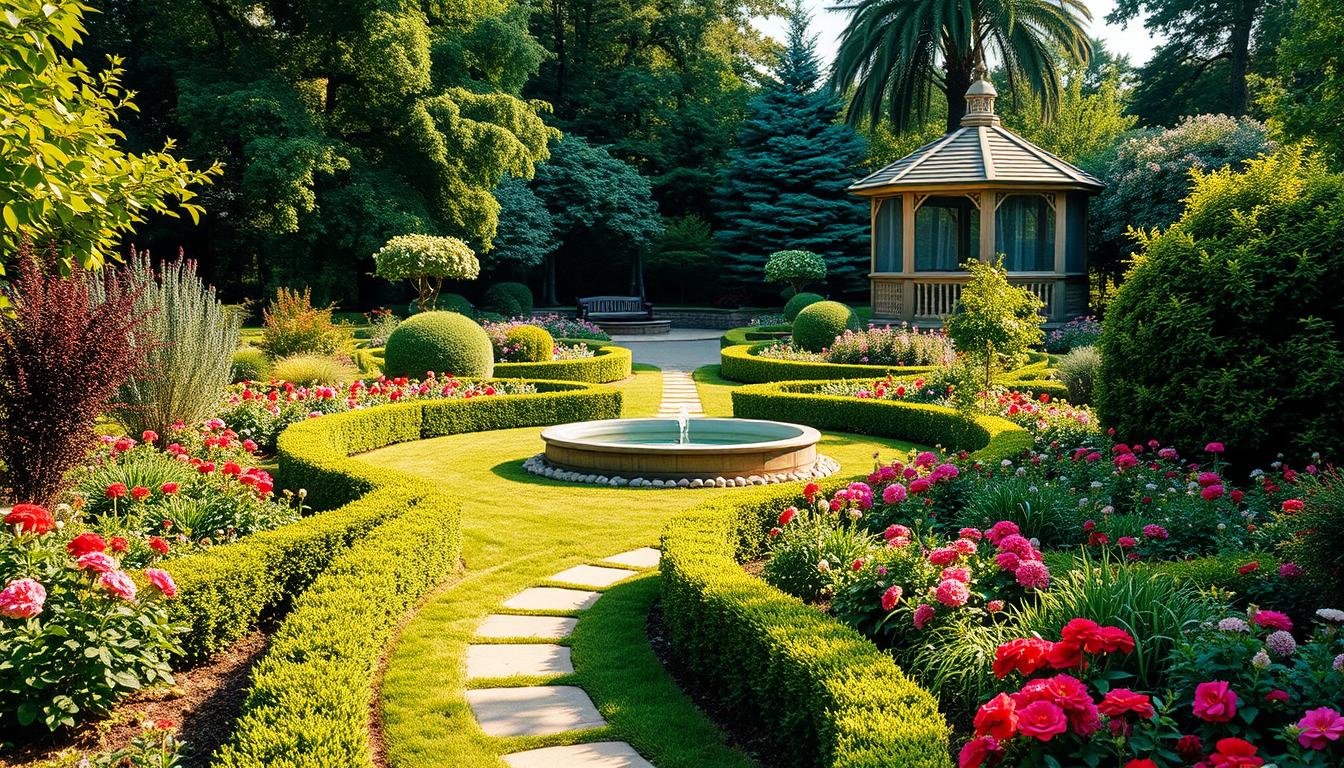Transforming your outdoor area into a functional and beautiful retreat is easier than you think. Whether you’re a beginner or an experienced enthusiast, thoughtful design can make all the difference. It’s about maximizing your space, enhancing curb appeal, and creating a place you’ll love spending time in.
Take Lori, for example. She started with a small 10’x10’ plot and, over 15 years, turned it into a stunning outdoor haven. Her journey shows that with the right approach, anyone can achieve their dream space.
This guide will walk you through essential steps like choosing the perfect location, preparing the soil, and selecting the right plants. We’ll also explore creative techniques like vertical gardening to make the most of your area. Our goal is to make the process simple and enjoyable, helping you overcome any overwhelm.
Key Takeaways
- Intentional design maximizes your outdoor area’s potential.
- Thoughtful planning enhances curb appeal and functionality.
- Real-world examples inspire achievable transformations.
- Essential steps include location selection and soil preparation.
- Creative techniques like vertical gardening optimize space.
Introduction to Garden Planning Design
Many dream of a lush retreat, but turning that vision into reality requires a clear plan. Lori, with 18 years of experience, has transformed countless areas into thriving spaces. Her journey shows that even small efforts can lead to stunning results.
One common struggle is the “This is the year” mentality. Many start with big ideas but face challenges in implementation. Breaking down complex projects into manageable steps is key. Three Acre Farm’s proven methodology emphasizes this approach, making it easier to achieve your goals.
Starting small is often the best way to ensure success. For example, a 3’x12’ bed can be a great beginning. Overambitious projects often lead to frustration, while smaller, focused efforts yield better results. Raised beds are an excellent solution for poor soil, making them a popular choice for beginners.
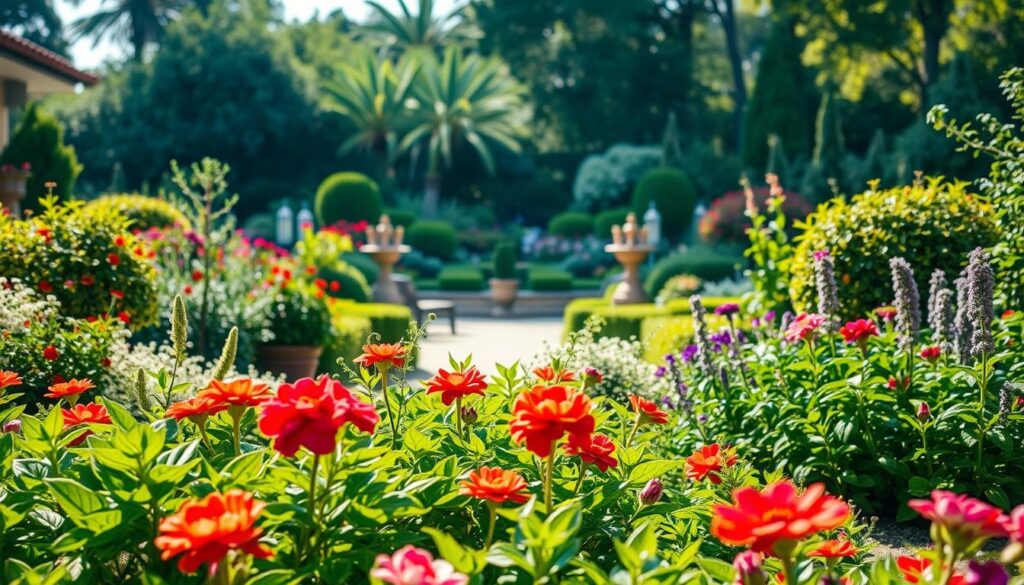
Planning tools like graph paper sketches or digital spreadsheets can help visualize your ideas. These tools make it easier to organize your thoughts and create a cohesive layout. Urban patios, for instance, have been transformed into productive spaces using these methods.
Here’s a comparison of planning tools to help you decide which works best for you:
| Tool | Pros | Cons |
|---|---|---|
| Graph Paper Sketches | Easy to use, no tech required | Limited flexibility, hard to edit |
| Digital Spreadsheets | Highly customizable, easy to edit | Requires tech skills, less tactile |
Success stories abound, from community gardens to raised bed solutions. These examples inspire and show that with the right approach, anyone can create a beautiful and functional outdoor area. Start small, plan carefully, and watch your vision come to life.
Choosing the Right Location for Your Garden
Finding the perfect spot for your outdoor project is the first step to success. A well-chosen location ensures your plants thrive and your space flourishes. Start by evaluating the area’s sunlight, water access, and soil quality. These factors will determine how well your plants grow and how much effort you’ll need to maintain them.

Assessing Sunlight and Shade
Plants need at least 8 hours of sun daily to thrive. Use smartphone apps or traditional observation methods to map sunlight patterns in your area. For north-facing spaces, consider reflective surfaces to maximize light exposure. Lori’s tip: “Location trumps size every time.” A smaller, sunlit area often outperforms a larger, shaded one.
Access to Water Sources
Easy access to water is essential for a healthy outdoor space. Rain barrel systems and soaker hoses are creative solutions for efficient watering. If you’re in a community area, explore shared water resources. Proper hydration ensures your plants stay vibrant and productive.
Finally, test your soil using simple hacks like mason jars and vinegar/baking soda. This quick check helps you understand its composition and make necessary adjustments. Whether you’re using raised beds or planting directly in the ground, the right location sets the foundation for a thriving outdoor area.
Understanding Soil Types and Preparation
Healthy soil is the foundation of any thriving outdoor space. It’s the key to growing strong plants and ensuring your area flourishes. Whether you’re working with clay, sand, or something in between, understanding your soil type is the first step to success.

Testing your soil is a simple yet effective way to determine its texture and pH level. A quick ribbon test can reveal whether your soil is clay-heavy or sandy. For pH, use a simple kit or DIY methods like vinegar and baking soda. Knowing these things helps you make the right adjustments for your plants.
Testing Your Soil
Start by performing a soil texture ribbon test. Take a handful of moist soil and roll it into a ball. If it forms a ribbon, it’s clay-heavy. If it crumbles, it’s sandy. This test gives you a clear idea of your soil’s composition.
Next, check the pH level. Most plants thrive in slightly acidic to neutral soil (pH 6.0-7.0). Use a pH testing kit or DIY methods for quick results. Adjusting pH is a straightforward way to improve your soil’s health.
Improving Soil Quality
Once you know your soil type, it’s time to enhance its quality. For clay soil, add sand and organic matter to improve drainage. Sandy soil benefits from compost and peat moss to retain moisture. Raised beds are another great solution for poor soil conditions.
Here are some proven methods to boost soil health:
- Build lasagna gardens by layering cardboard, greens, and browns.
- Use compost tea recipes to enrich the soil with nutrients.
- Install worm towers to encourage natural aeration and fertilization.
With the right preparation, your soil will support vibrant plants and a thriving outdoor space. Start small, test often, and watch your efforts pay off.
Selecting the Right Plants for Your Garden
Choosing the right plants can transform your space into a vibrant, thriving haven. Whether you’re aiming for colorful blooms or a haven for pollinators, the options are endless. Understanding the differences between annuals and perennials, as well as the benefits of native species, will help you make informed decisions.

Annuals vs. Perennials
Annuals, like marigolds and petunias, bloom for one season and are perfect for instant color. Perennials, such as lavender and coneflowers, return year after year, offering long-term value. For first-year projects, a mix of both can provide immediate impact while building a lasting foundation.
Here’s a quick cost-benefit analysis:
- Annuals: Lower upfront cost, high visual impact.
- Perennials: Higher initial investment, long-term savings.
Native Plants and Pollinators
Native plants are adapted to your region, making them low-maintenance and eco-friendly. They also attract bees, butterflies, and other pollinators, supporting local ecosystems. Consider standout varieties like ‘ProCut Orange’ sunflowers or ‘Queen Lime’ zinnias for a vibrant display.
Companion planting is another smart strategy. Pairing certain plants can improve pest control and boost yields. For example, marigolds deter pests, while basil enhances tomato growth.
For those looking to go the extra mile, a DIY pollinator hotel is a fun project. Use bamboo bundles and reclaimed wood to create a safe haven for beneficial insects. It’s a simple way to support biodiversity while adding charm to your space.
Ready to get started? Check out our beginner’s guide for more tips on creating your perfect outdoor retreat.
Designing Your Garden Layout
Creating a cohesive and efficient layout is the key to maximizing your outdoor space. Whether you’re working with a small plot or a larger area, thoughtful organization ensures functionality and beauty. Start by deciding between raised beds and in-ground planting, then focus on pathways and zones to enhance accessibility and flow.
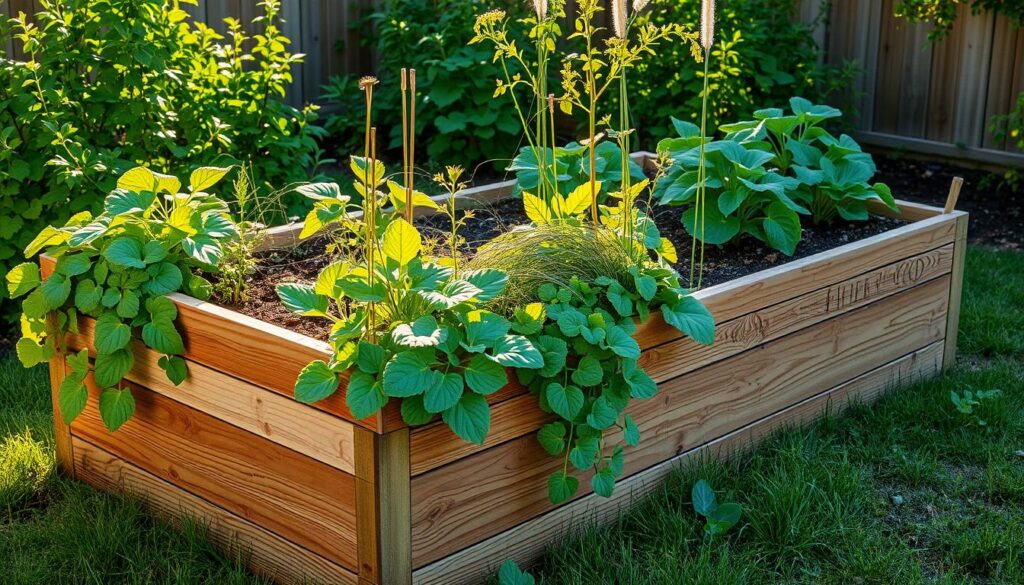
Raised Beds vs. In-Ground Planting
Raised beds offer several advantages, especially for those dealing with poor soil or limited mobility. A 3’ wide bed is ideal for easy access and maintenance. Materials like cedar, composite, and stone each have their benefits:
- Cedar: Naturally rot-resistant and durable.
- Composite: Low-maintenance and long-lasting.
- Stone: Adds a rustic, permanent look.
In-ground planting, on the other hand, works well for larger areas and is cost-effective. Consider ergonomic principles to make gardening accessible and enjoyable for everyone.
Creating Pathways and Zones
Pathways are essential for navigating your space without compacting soil. Aim for a width of 2-3 feet to allow comfortable movement. Surfacing options include:
- Gravel: Affordable and easy to install.
- Mulch: Soft underfoot and eco-friendly.
- Stepping stones: Adds a decorative touch.
Divide your space into zones based on maintenance needs. High-care areas for vegetables or flowers can be placed closer to water sources, while low-care zones for native plants require less attention. Vertical integration, like trellis systems, can further optimize your layout.
Incorporating Vertical Gardening with Trellises
Vertical gardening with trellises is a game-changer for urban and small-space growers. It’s a smart way to maximize your space while adding beauty and functionality. Whether you’re working with a balcony, patio, or backyard, trellises can help you grow more plants in less area.
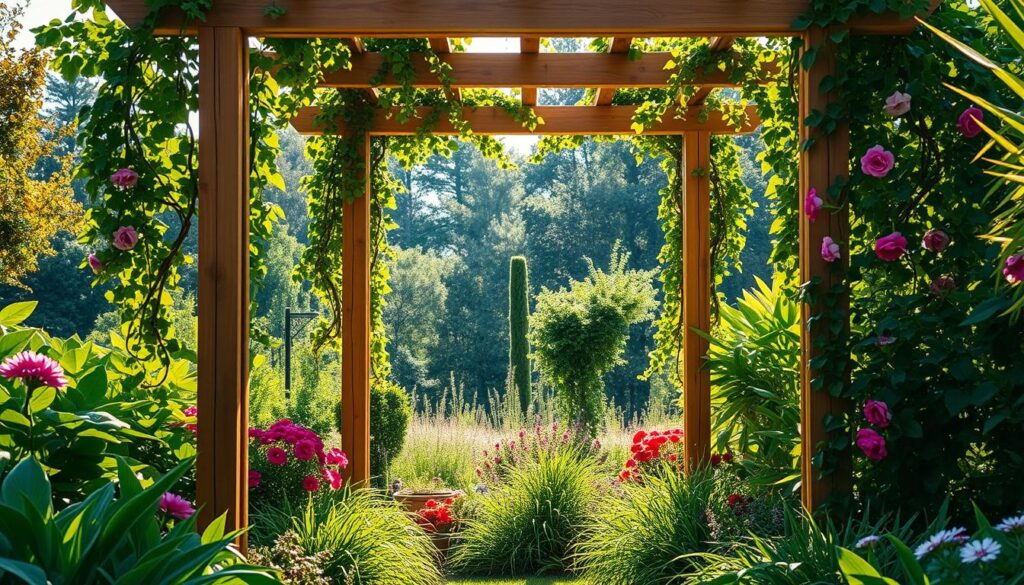
Benefits of Trellises
Trellises offer numerous advantages for your outdoor area. They provide structural support for vining plants, improve air circulation, and reduce the risk of pests and diseases. According to Gardenary, trellises can increase yields by up to 400% in the same footprint.
Here are some key benefits:
- Space-saving: Grow vertically to free up ground area.
- Seasonal versatility: Use trellises for spring peas, summer beans, and autumn gourds.
- Improved plant health: Better airflow reduces mold and mildew.
Best Plants for Vertical Gardening
Not all plants are suited for trellises, but many thrive in vertical setups. Vining varieties like cucumbers, tomatoes, and pole beans are excellent choices. For flowers, consider climbing roses or morning glories.
Here’s a quick guide to popular trellis-friendly plants:
| Plant | Support Type | Season |
|---|---|---|
| Tomatoes | Florida weave or single-stem pruning | Summer |
| Cucumbers | Cattle panel arch | Spring to Fall |
| Peas | Netting or bamboo stakes | Spring |
For DIY enthusiasts, building a cattle panel arch is a fun and practical project. Ensure the structure is sturdy and safe, especially for heavy crops like gourds. As one gardener put it,
“Trellises are the backbone of a thriving vertical garden.”
With the right approach, trellises can transform your outdoor area into a productive and visually stunning retreat. Start small, experiment with different plants, and enjoy the benefits of vertical gardening.
Planning for Year-Round Garden Beauty
Keeping your outdoor space vibrant throughout the year is easier than you might imagine. With a few smart strategies, you can ensure your area stays beautiful in every season. From colorful blooms in spring to textured bark in winter, there’s always something to admire.
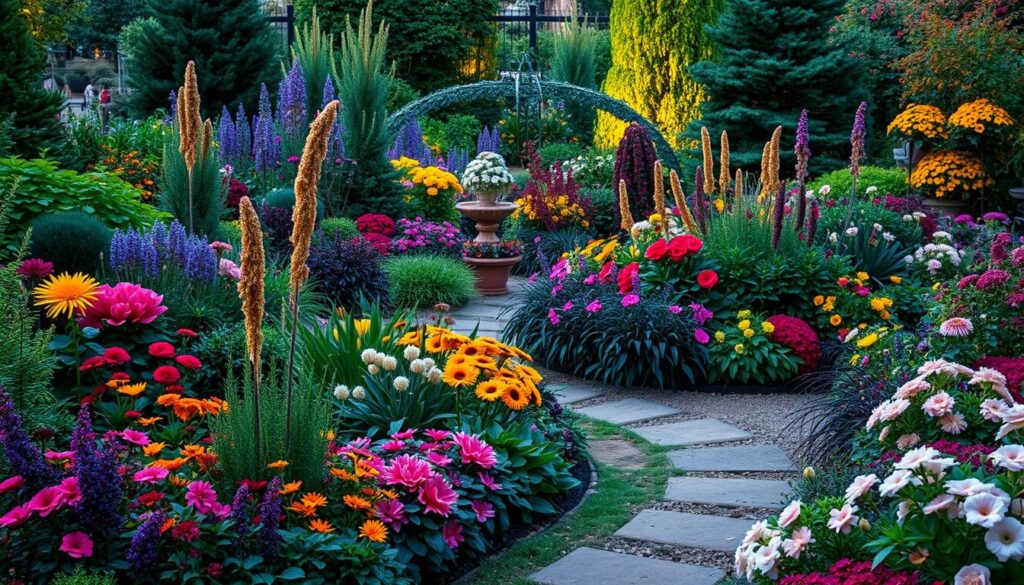
Seasonal Planting Tips
Succession planting is a great way to keep your space lively. Start with early bloomers like pansies in spring, followed by summer favorites like zinnias. In fall, switch to ornamental kale and chrysanthemums for a pop of color. This approach ensures continuous beauty and maximizes your area’s potential.
Here are some ideas to inspire your seasonal planting:
- Use a planting schedule template to stay organized.
- Experiment with container designs for flexibility.
- Choose four-season picks like red twig dogwood for lasting interest.
Winter Interest Plants
Winter doesn’t have to mean a dull outdoor space. Plants like hellebores bloom even in colder months, adding life to your area. Bark texture plants, such as red twig dogwood or birch trees, create visual appeal when other plants are dormant.
For holiday charm, consider living wreaths made with evergreen branches. They’re a festive way to integrate natural elements into your decor. Additionally, snow-melt microclimates can be utilized to grow hardy varieties in unexpected spots.
With these tips, your space can shine all year long. Start small, experiment with different plants, and enjoy the beauty of every season.
Watering and Irrigation Systems
Proper watering is the backbone of a thriving outdoor space. Whether you’re growing flowers, vegetables, or shrubs, ensuring they get the right amount of water is essential. With the right techniques and tools, you can save time and resources while keeping your plants healthy.
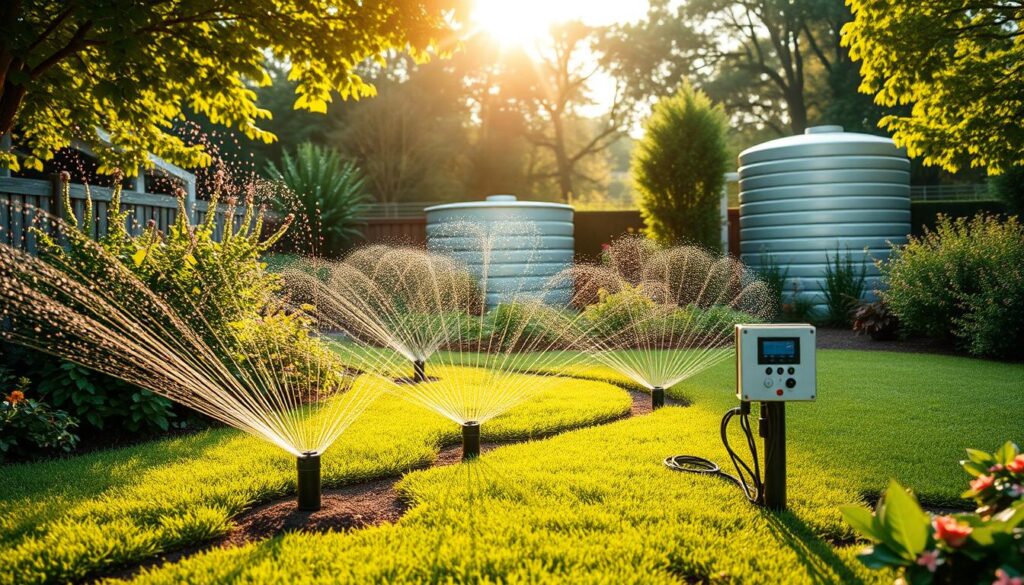
Efficient Watering Techniques
Smart watering practices can make a big difference. For example, watering early in the morning reduces evaporation and ensures plants absorb moisture effectively. Here are some tips to optimize your routine:
- Use a smart controller like Rachio or Orbit to automate schedules based on weather conditions.
- Create a drought-tolerant plant cheat sheet to prioritize water for the most resilient species.
- DIY ollas from terracotta pots are a simple and effective way to deliver water directly to plant roots.
Installing Drip Irrigation
Drip irrigation systems are a game-changer for efficient watering. They deliver water directly to the soil, minimizing waste and maximizing plant health. Here’s how to get started:
- Calculate your rainwater harvesting potential by measuring your roof’s square footage and converting it to gallon yield.
- Use kitchen timers to detect leaks in your system—an easy trick to save time and prevent water loss.
- Choose the right components, such as emitters and tubing, to customize your setup for different plant needs.
With these strategies, you can create a reliable irrigation system that keeps your outdoor space lush and vibrant. Start small, experiment with different methods, and enjoy the benefits of efficient watering.
Organic Gardening Practices
Embracing organic methods can transform your outdoor space into a sustainable haven. By focusing on natural techniques, you can create a healthier environment for your plants and the ecosystem. Organic gardening is not just about avoiding chemicals—it’s about nurturing the soil, supporting beneficial insects, and promoting long-term sustainability.
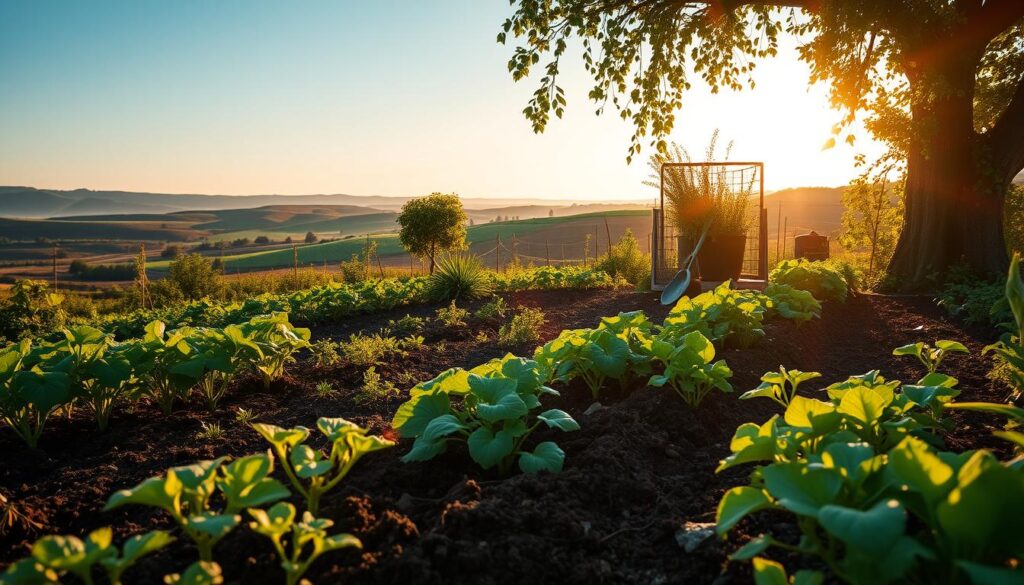
Composting and Mulching
Composting is a cornerstone of organic gardening. It turns kitchen scraps and yard waste into nutrient-rich soil. There are two main methods: hot and cold composting. Hot composting breaks down materials quickly, while cold composting is slower but requires less effort.
Here are some tips for effective composting:
- Balance green (nitrogen-rich) and brown (carbon-rich) materials.
- Turn the pile regularly to speed up decomposition.
- Keep the compost moist but not soggy.
Mulching is another essential practice. It helps retain moisture, suppress weeds, and regulate soil temperature. The depth of mulch depends on the plant type:
- 2-3 inches for vegetables and flowers.
- 3-4 inches for trees and shrubs.
Natural Pest Control
Managing pests without chemicals is a key part of organic gardening. Natural pest control methods protect your plants while keeping the ecosystem balanced. For example, garlic spray is an effective solution for aphids. Simply mix crushed garlic with water, strain, and spray on affected plants.
Other strategies include:
- Building a beneficial insect hotel to attract pollinators and predators.
- Practicing crop rotation to prevent disease buildup.
- Using companion planting to deter pests naturally.
By adopting these organic practices, you can create a thriving and eco-friendly outdoor space. Start small, experiment with different techniques, and enjoy the benefits of sustainable gardening.
Creating a Pollinator-Friendly Garden
Supporting pollinators is a rewarding way to enhance your outdoor space. Bees, butterflies, and other beneficial insects play a crucial role in maintaining a healthy ecosystem. By creating a haven for these creatures, you not only support biodiversity but also add beauty and vibrancy to your surroundings.
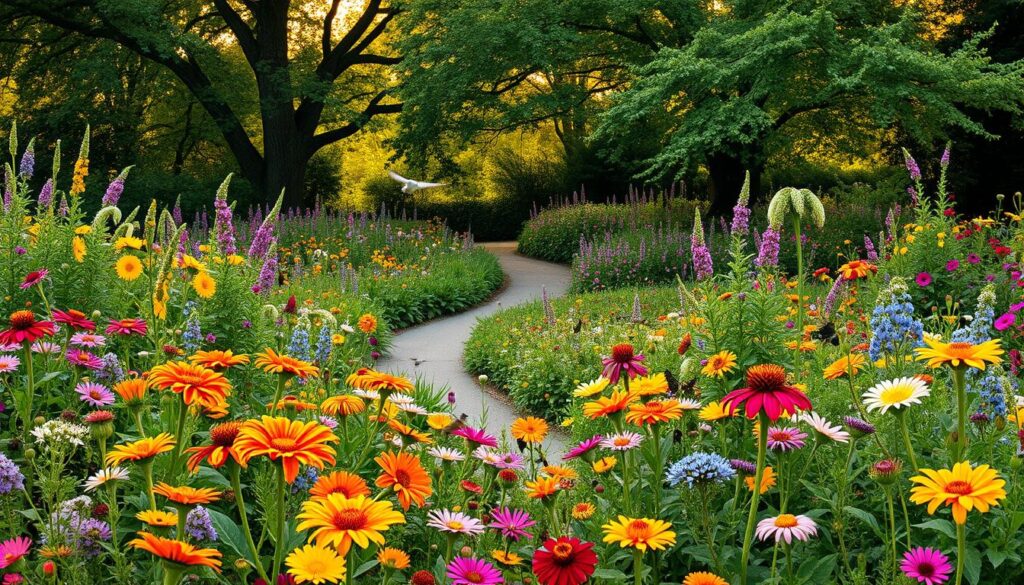
Plants That Attract Bees and Butterflies
Choosing the right plants is key to attracting bees and butterflies. Native wildflowers like coneflowers, milkweed, and black-eyed Susans are excellent choices. These plants provide nectar and pollen, essential for pollinator survival.
Here’s a quick guide to some top picks:
| Plant | Benefits |
|---|---|
| Milkweed | Host plant for monarch butterflies |
| Coneflowers | Attracts bees and butterflies, drought-tolerant |
| Lavender | Fragrant, attracts bees, and repels pests |
Designing for Pollinators
When planning your space, focus on creating a design that supports pollinators throughout the year. Plant in clusters to make it easier for insects to find food. Include a mix of early, mid, and late-blooming varieties to ensure a continuous nectar supply.
Here are some additional tips:
- Create a pesticide-free zone to protect pollinators.
- Add a butterfly puddling station using a shallow dish filled with sand and water.
- Incorporate night-blooming plants like moonflowers to support moths.
By following these steps, you can transform your space into a thriving sanctuary for bees, butterflies, and other beneficial insects. Start small, experiment with different plants, and enjoy the rewards of a pollinator-friendly area.
Garden Maintenance and Care
Maintaining your outdoor space doesn’t have to be overwhelming—simple routines can keep it thriving. With the right tools and techniques, you can ensure your area stays healthy and beautiful all year long. Let’s explore some essential tasks like pruning, weeding, and mulching to make maintenance easier and more effective.
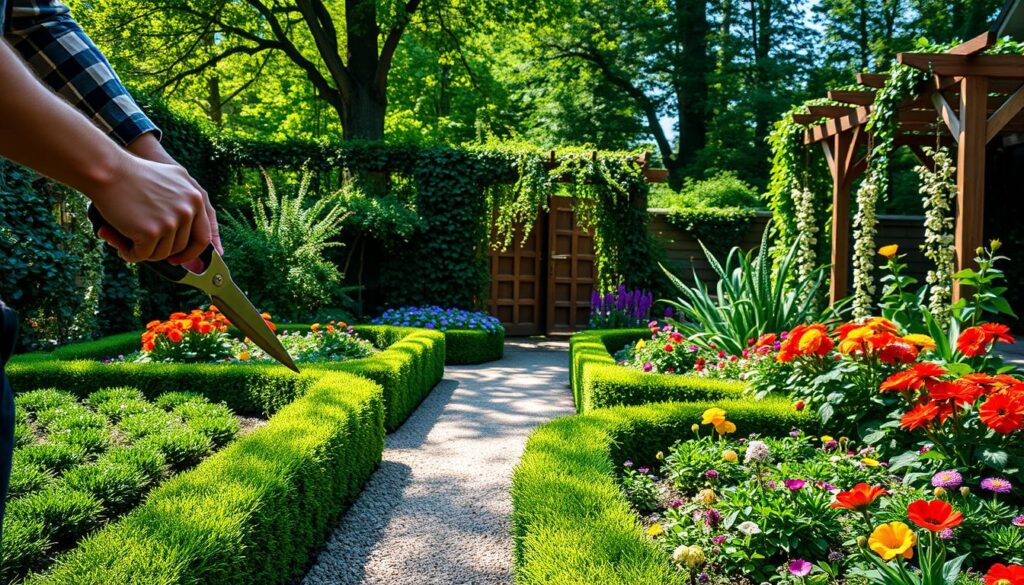
Pruning and Deadheading
Pruning is a key task to keep your plants healthy and well-shaped. It involves removing dead or overgrown branches to encourage new growth. For shrubs like roses and hydrangeas, seasonal pruning calendars can guide you on the best time to trim.
Deadheading, or removing spent flowers, is another important practice. It helps plants focus their energy on producing new blooms rather than seeds. Lori’s tip: “A sharp pair of shears makes all the difference—dull tools can damage plants.”
Here’s a quick guide to pruning common shrubs:
| Shrub | Best Time to Prune |
|---|---|
| Roses | Late winter or early spring |
| Hydrangeas | After blooming in summer |
| Boxwood | Late spring or early summer |
Weeding and Mulching
Weeding is essential to prevent unwanted plants from competing with your favorites. A weed identification guide can help you spot and remove invasive species effectively. For persistent weeds, soil solarization—covering the soil with plastic to trap heat—can be a game-changer.
Mulching is another must-do task. It helps retain moisture, suppress weeds, and regulate soil temperature. Organic mulches like wood chips or straw also enrich the soil as they break down. Lori recommends: “A 2-3 inch layer of mulch is perfect for most plants.”
Here are some tips for effective weeding and mulching:
- Use ergonomic tools to reduce strain, especially for arthritic hands.
- Create a sharpening station to keep your tools in top condition.
- Apply mulch in early spring or late fall for the best results.
“Consistency is key—small, regular maintenance tasks save time and effort in the long run.”
By incorporating these practices into your routine, you can keep your outdoor space looking its best. Start with these simple things, and enjoy the rewards of a well-maintained area.
Designing a Kitchen Garden
A kitchen garden is a practical and rewarding way to grow fresh produce right outside your door. Whether you’re a seasoned gardener or just starting, this approach allows you to enjoy homegrown herbs, vegetables, and fruits with minimal effort. Jon Carloftis, a renowned designer, emphasizes the importance of combining functionality with aesthetics in your plan.
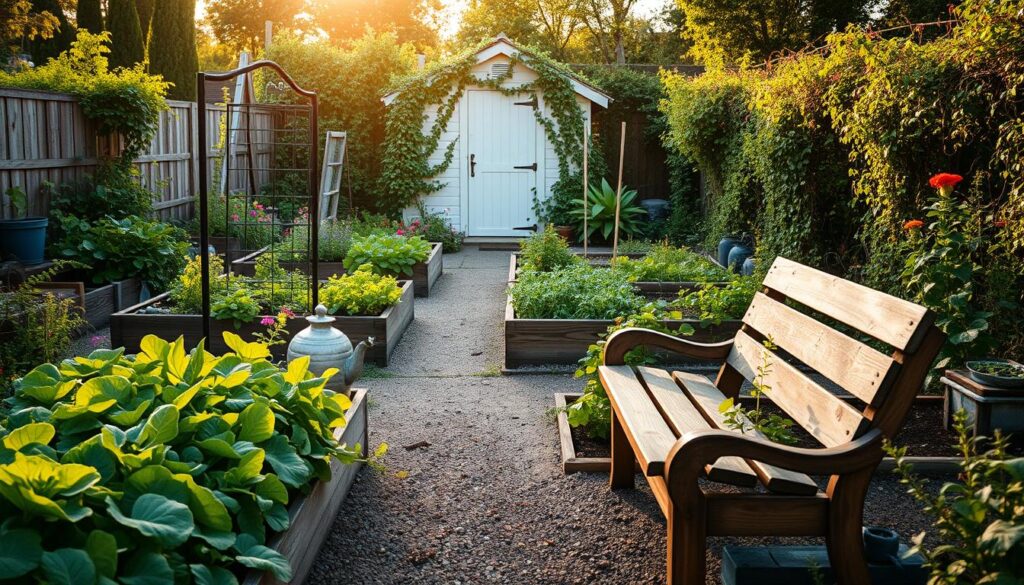
Choosing Edible Plants
Selecting the right edible plants is the first step to a successful kitchen garden. Focus on varieties that thrive in your climate and suit your cooking needs. For example, basil, parsley, and thyme are excellent herbs for beginners. Vegetables like tomatoes, peppers, and lettuce are also great choices for small spaces.
Consider these tips for a thriving kitchen garden:
- Use vertical planters, such as salad walls made from pallets, to save space.
- Build a culinary herb spiral for easy access and visual appeal.
- Follow a succession planting chart to ensure continuous harvests.
Layout and Spacing Tips
Proper spacing is crucial for healthy plant growth. Overcrowding can lead to competition for nutrients and increased pest problems. For raised beds, a 3’ width is ideal for easy access and maintenance. Here’s a quick guide to spacing for common plants:
| Plant | Spacing |
|---|---|
| Tomatoes | 18-24 inches |
| Lettuce | 6-8 inches |
| Basil | 12 inches |
Integrate a preserving station into your plan for convenience. This area can include drying racks or canning supplies. For families, a kids’ pizza garden theme is a fun way to involve children in gardening. Plant tomatoes, basil, and peppers to create their own pizza ingredients.
Ready to start your kitchen garden? Check out our beginner’s guide for more tips and inspiration.
Incorporating Hardscaping Elements
Adding hardscaping elements to your outdoor space can elevate its functionality and aesthetic appeal. These features not only enhance the landscape but also create practical areas for relaxation and entertainment. From patios to water features, hardscaping offers endless possibilities to transform your space.
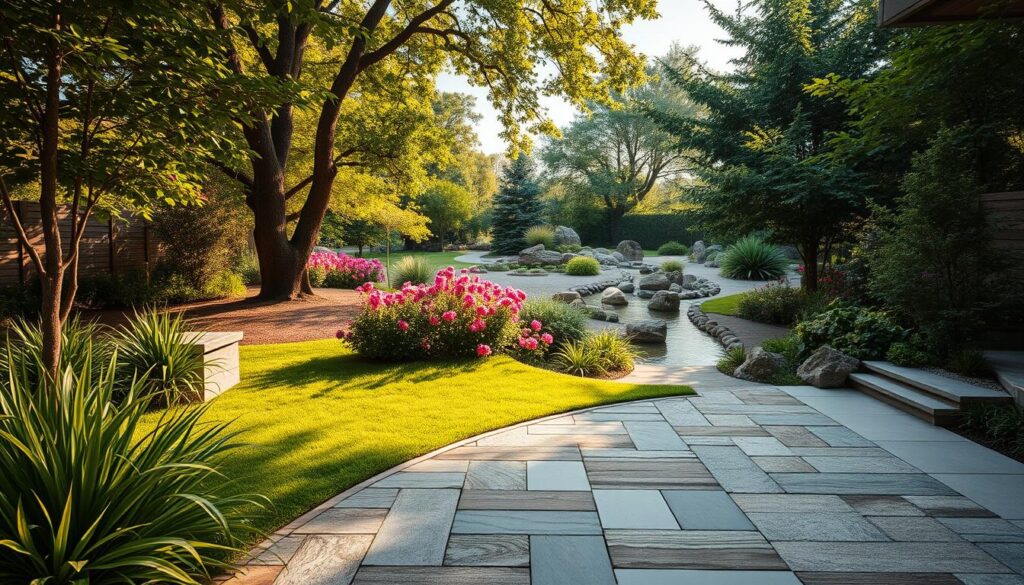
Patios and Decks
Patios and decks are essential for creating usable outdoor areas. They provide a way to enjoy your space while adding value to your property. When choosing materials, consider permeable paving options for better drainage and sustainability.
Fire pits are another popular addition. Ensure they are placed in safe zones and use materials like stone or brick for durability. Here’s a quick comparison of patio materials:
| Material | Pros | Cons |
|---|---|---|
| Concrete | Durable, customizable | Can crack over time |
| Wood | Natural look, warm feel | Requires regular maintenance |
| Stone | Elegant, long-lasting | Expensive, heavy |
Garden Structures and Features
Garden structures like arbors and trellises add charm and functionality to your landscape. Arbors, for example, can be installed step-by-step to create shaded walkways or support climbing plants. Whiskey barrel water features are another creative option, adding a soothing element to your space.
For privacy, consider screening vine solutions. These not only block unwanted views but also add greenery to your area. Outdoor kitchens are another great feature, combining practicality with style. Plan for ample counter space and storage to make cooking outdoors a breeze.
Lighting is crucial for both ambiance and security. Use a mix of pathway lights, string lights, and spotlights to highlight key areas. As one designer put it,
“Lighting can transform a space from ordinary to extraordinary.”
By incorporating these hardscaping elements, you can create a landscape that is both beautiful and functional. Start small, experiment with different features, and enjoy the process of transforming your outdoor area.
Conclusion
Creating your ideal outdoor retreat is within reach, no matter your experience level. Many have transformed their spaces into stunning havens, proving that a dream garden is achievable with the right steps. From small plots to expansive areas, every journey starts with a single seed.
Ready to take the next step? Explore our Backyard Cutting Garden 101 course for hands-on guidance. Download our seasonal checklist to stay organized and inspired throughout the year. Join the #MyFirstGarden challenge and share your progress with a supportive community.
Remember, your perfect space grows one step at a time. With dedication and creativity, you can create a garden that reflects your vision and brings joy for years to come. Start today—your outdoor retreat awaits!

